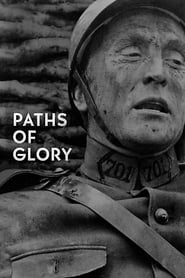
Stanley Kubrick, at the beginning of his career, made, in “Paths of Glory”, the greatest anti-war film ever made. It is a theme that the great Kubrick would return to with Dr. Strangelove (the cold war) and Full Metal Jacket (the Vietnam War). “Paths of Glory” is based on the most devastating of Wars. The killing machine that was World War 1, where regimented cold bureaucratic worlds collided with the new modern technological killing machines for the first time. The story follows a true story that occurred in the French Army, but it could have happened with any of the fighting armies during that terrible time. It was a war where thousands of wasted lives were ended daily for absolutely no reason as both sides sat in trenches and just shot at each other for no gain or reason. It was a perfect setting for a message of madness and Kubrick was fascinated by madness. Kirk Douglas plays Colonel Dax who is ordered once again to send his troops on a suicide attack to the nearby trenched in hill called Ant Hill. The General who sends him there does so with visions of a promotion dancing in his head. The first wave is cut down immediately with their bodies falling back in the trench onto their comrades. The rest of the soldiers in seeing the pointlessness of continuing the attack stay in the trench. The stupid selfish General Mireau (George Macready) was given the idea of the wasted attack by his smarter and colder superior General Broulard (Adolphe Menjou). Mireau is so humiliated by the failure that he orders all the remaining soldiers shot, but Broulard knowing that they need the soldiers to die another day, convinces him to shoot one person from each platoon. The soldiers are picked by their own men. One because he witnessed his Sargent’s cowardly act the night before that caused the death of a soldier, one because he is not liked and a strange character, while the third was picked randomly by lot. Dax, who was a lawyer in civilian life attempts to defend them in the military kangaroo court. The result is bitter and agonizingly hopeless. Watching the film made me want to shout out in anger numerous times. The story is so strong that it would make for a good film with almost any director. In Kubrick’s hands however it becomes an unforgettable, while not very pleasant, viewing experience. It is here that Kubrick developed the long following tracking shot that he would become so famous for in his later films. The film starts with Mireau walking through the trenches inspecting his men after another long bloody day of fighting. The camera tracks and follows him as he gleefully sees and gloats at his men’s suffering and this long tracking shot never seems to end, relaying to me a feeling of being inside the trench with this horrible man. Kubrick was famous for using extremely deep focused photography and he uses it wisely here. I felt that I could almost touch and feel the hard rocky terrain. The battle scenes are shot low and pointing upward, rising above the screen as to emphasize the immediate danger and horror of the battle. The military court scenes are paced with precision as Kubrick’s camera will always let us know by way of a close up, as to what the judges are thinking during the obvious facts that Dax raises at the trial. At the beginning of the trial the scenes are filmed like a normal trial from a distance while slowly and intently the viewer comes to realize the futility of it all. Many have said that Kubrick makes visually stunning but cold films. I beg to differ as his camera ingrains deep emotions in cold procedures. Paths of Glory is his most emotional and searing film. The predicaments of the condemned are brought to the fore with one of the saddest executions put on film. Then there is the ending that has nothing to do with the story but is so fitting in its feel and poignant scream of humanity. Paths of Glory is a thought provoking, brilliant and visually stunning masterpiece.

